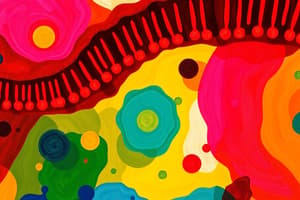Podcast
Questions and Answers
Which type of protein is found in all cell membranes of multicelled organisms?
Which type of protein is found in all cell membranes of multicelled organisms?
- Transport proteins
- Receptor proteins
- Adhesion proteins
- All of the above (correct)
When a living cell is placed in a hypotonic solution, what will most likely happen to the water inside the cell?
When a living cell is placed in a hypotonic solution, what will most likely happen to the water inside the cell?
- Water will move out rapidly by exocytosis
- Water will show no net movement
- Water will move out of the cell
- Water will move into the cell (correct)
Which substances can readily diffuse across a lipid bilayer?
Which substances can readily diffuse across a lipid bilayer?
- Only glucose
- Only oxygen
- Only carbon dioxide
- More than one of the above (correct)
What type of transport do sodium ions utilize to cross a membrane with the help of energy?
What type of transport do sodium ions utilize to cross a membrane with the help of energy?
In a lipid bilayer, which correctly describes the arrangement of lipid molecules?
In a lipid bilayer, which correctly describes the arrangement of lipid molecules?
Which type of membrane transport requires a protein and moves substances along the concentration gradient?
Which type of membrane transport requires a protein and moves substances along the concentration gradient?
Identify the type of membrane transport that does not require energy or a protein.
Identify the type of membrane transport that does not require energy or a protein.
What is the sodium/potassium pump an example of?
What is the sodium/potassium pump an example of?
Which type of membrane transport requires the input of energy in the form of ATP?
Which type of membrane transport requires the input of energy in the form of ATP?
Which process is categorized under endocytosis and involves the engulfing of solids?
Which process is categorized under endocytosis and involves the engulfing of solids?
Which type of membrane transport is primarily involved in bulk movement across the membrane?
Which type of membrane transport is primarily involved in bulk movement across the membrane?
What is the main function of the cell membrane?
What is the main function of the cell membrane?
Which molecules in the cell membrane are primarily responsible for forming channels and pumps?
Which molecules in the cell membrane are primarily responsible for forming channels and pumps?
What drives the process of diffusion?
What drives the process of diffusion?
When molecules are evenly distributed on both sides of a membrane, what happens to their movement?
When molecules are evenly distributed on both sides of a membrane, what happens to their movement?
What does osmosis specifically refer to in membrane transport?
What does osmosis specifically refer to in membrane transport?
What occurs to an animal cell placed in fresh water due to osmotic pressure?
What occurs to an animal cell placed in fresh water due to osmotic pressure?
Which process describes the uptake of liquids by the cell via membrane invagination?
Which process describes the uptake of liquids by the cell via membrane invagination?
Flashcards
Cell Membrane Components
Cell Membrane Components
Multicellular organism cell membranes contain transport proteins, receptor proteins, and adhesion proteins.
Hypotonic Solution
Hypotonic Solution
A hypotonic solution has a lower solute concentration than the cell, causing water to move into the cell.
What can cross a lipid bilayer?
What can cross a lipid bilayer?
Small, nonpolar molecules like oxygen and carbon dioxide can easily pass through the lipid bilayer.
Active Transport
Active Transport
Signup and view all the flashcards
Lipid Bilayer Structure
Lipid Bilayer Structure
Signup and view all the flashcards
Membrane Function
Membrane Function
Signup and view all the flashcards
Facilitated Diffusion
Facilitated Diffusion
Signup and view all the flashcards
Simple Diffusion
Simple Diffusion
Signup and view all the flashcards
Endocytosis
Endocytosis
Signup and view all the flashcards
Bulk Passage
Bulk Passage
Signup and view all the flashcards
Osmosis
Osmosis
Signup and view all the flashcards
Cell Membrane Function
Cell Membrane Function
Signup and view all the flashcards
What are cell membrane channels and pumps made of?
What are cell membrane channels and pumps made of?
Signup and view all the flashcards
What is diffusion driven by?
What is diffusion driven by?
Signup and view all the flashcards
Cell membrane, water and pressure
Cell membrane, water and pressure
Signup and view all the flashcards
Study Notes
Cell Membrane Transport
- Cell membranes in multicellular organisms contain transport proteins, receptor proteins, and adhesion proteins.
Hypotonic Solutions
- Immersed in a hypotonic solution, water moves into a cell.
Lipid Bilayer Permeability
- Several types of molecules, including oxygen, carbon dioxide, and glucose, can diffuse across a lipid bilayer.
Active Transport
- Active transport utilizes transport proteins and energy (ATP) to move substances against the concentration gradient.
Lipid Bilayer Structure
- Hydrophobic tails of lipid molecules are sandwiched between hydrophilic heads.
Membrane Proteins
- Proteins are primarily responsible for membrane functions.
Facilitated Diffusion
- Facilitated diffusion is the movement of substances across a membrane with the help of transport proteins, following the concentration gradient, requiring no energy input.
Simple Diffusion
- Simple diffusion is the movement of substances across a membrane, without proteins, following the concentration gradient, requiring no energy input.
Types of Membrane Transport
- Facilitated Diffusion: Transport with a protein, down the concentration gradient
- Active Transport: Transport against the concentration gradient, requiring energy (ATP).
- Endocytosis: Bulk transport into the cell via membrane invagination (e.g., phagocytosis, pinocytosis)
Sodium-Potassium Pump
- The sodium-potassium pump is a crucial example of active transport.
Exocytosis
- Not explicitly mentioned in the questions but important: Bulk transport out of the cell.
General Cellular Processes
- Cell membranes: regulate what enters and exits a cell
- Membrane proteins (channels/pumps): composed of proteins; responsible for transport.
- Diffusion: Movement of molecules from high to low concentration.
- Osmosis: Diffusion of water across a selectively permeable membrane.
Osmotic Pressure and Animal Cells
- Water moves into animal cells in a hypotonic solution leading to potential cell lysis (bursting).
Bulk Transport
- Endocytosis is a type of bulk transport involving the intake of large molecules via membrane deformation (like pseudopods) into the cell. This includes:
- Phagocytosis (Solids)
- Pinocytosis (Liquids)
Studying That Suits You
Use AI to generate personalized quizzes and flashcards to suit your learning preferences.





